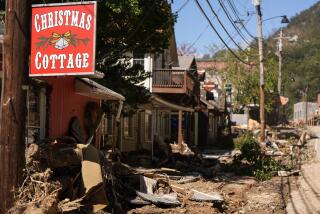Tracking Winds of Uncertainty
- Share via
MIAMI — Far out over the ocean, Hurricane Alberto--the first storm of the Atlantic season--is expected to take a turn to the north today, perhaps posing a danger only to ships at sea.
But for Max Mayfield, who’d have plenty of explaining to do if a storm defied all expectations and barreled into the U.S., neither Alberto nor any other tropical system is to be trusted.
“My job is to communicate the uncertainty,” said Mayfield, who earlier this year was named director of the National Hurricane Center here. “Our forecast error for a storm 24 hours away from landfall is 100 miles.” Translation: A hurricane that one day seems headed straight for Miami instead could slam into West Palm Beach or Key West the very next day.
In the last 57 years, only seven other men have served as chief of the hurricane center. Along with the responsibility of tracking and predicting the paths of potential killer storms, Mayfield also has inherited from them this nightmarish scenario:
“A major storm is making landfall and people are stuck in gridlock on highways. Make no mistake: We know what’s going to happen. With a big storm surge, there will be death by drowning. In strong winds, cars will be flipped over.
“That’s it,” Mayfield said, nodding his head slightly as if to dislodge the vision. “The responsibility is mine. That weight on my shoulders is the potential for loss of life.”
Mayfield, 51, is a native of Oklahoma City who fell in love with violent weather growing up in Tornado Alley. After earning an undergraduate degree in mathematics, he served as a forecaster in the Air Force and in 1972 became an intern at the hurricane center. He received his master’s degree in meteorology in 1987 and was named a hurricane specialist the following year. He served as deputy director to now-retired Jerry Jarrell last season.
With global coverage from eye-in-the-sky satellites, aircraft that penetrate storms to collect data and computer models that accurately predict the paths of great tempests, major mistakes in forecasting are rare. Mayfield and his elite team of six hurricane experts know precisely where storms are, the power of their winds and how fast they are moving.
But the precision of the forecast and the timing of when to post warnings influence billion-dollar decisions. The hurricane center, an agency of the National Oceanic and Atmospheric Administration, does not order evacuations or decide to close down a beach resort. Rather, those decisions are made by local and state governments--along with the leaders of dozens of nations in the Caribbean and Central and South America.
The pressure to be correct is immense.
“Over-warning is a problem,” Mayfield said. He is not the only weatherman who remembers 1985’s Hurricane Gloria, which tantalized the East Coast for days and then blew harmlessly out to sea, prompting CBS-TV anchor Dan Rather to ask then-hurricane center Director Neil Frank: Can we ever believe you again?
No one knows how many storms will develop in the Atlantic this year during the six-month season, which runs through November.
William Gray, a Colorado State University scientist who has proved to be accurate in the past, on Friday revised his prediction: 11 named storms, including seven hurricanes with sustained winds of 75 mph or above. Of those, Gray said, three storms likely will be major hurricanes--with top winds above 110 mph.
Gray said that, based on sea surface temperatures, he has lowered his prediction for the number of storms expected this year. But that number is still above average.
At greatest risk from tropical storms are 64 million residents of the Atlantic and Gulf Coast states, especially those who live near the shore. Areas Mayfield called “disasters waiting to happen” include Galveston, Texas; southeast Louisiana, including New Orleans; Florida’s southwest coast, from Tampa Bay to Naples; southeast Florida, from Key West to Palm Beach; and the Outer Banks of North Carolina.
“Evacuating those areas would take so long,” Mayfield said, “that it is just not going to happen.”
Surprisingly, however, beachfront residents are not the only ones in danger. In an about-to-be-published study, the hurricane center’s acting deputy director, Ed Rappaport, found that 59% of all deaths related to tropical storms from 1970 through 1999 resulted from drowning in fresh water--the aftermath of inland flooding. Among children, 78% of all storm-related deaths came in inland floods.
With more people in harm’s way, the ability to communicate a storm’s danger, especially to a TV audience, has become an increasingly critical part of the director’s job. And, concedes the soft-spoken Mayfield, “I am not a dynamo.
“But . . . we’re in an active period, with 41 land-falling storms in the last five years. Add that up and we have a big hurricane problem. So I guarantee you, if a major hurricane is threatening the East Coast, I’ll get the point across.”
Times researcher Anna M. Virtue contributed to this story.
More to Read
Sign up for Essential California
The most important California stories and recommendations in your inbox every morning.
You may occasionally receive promotional content from the Los Angeles Times.













